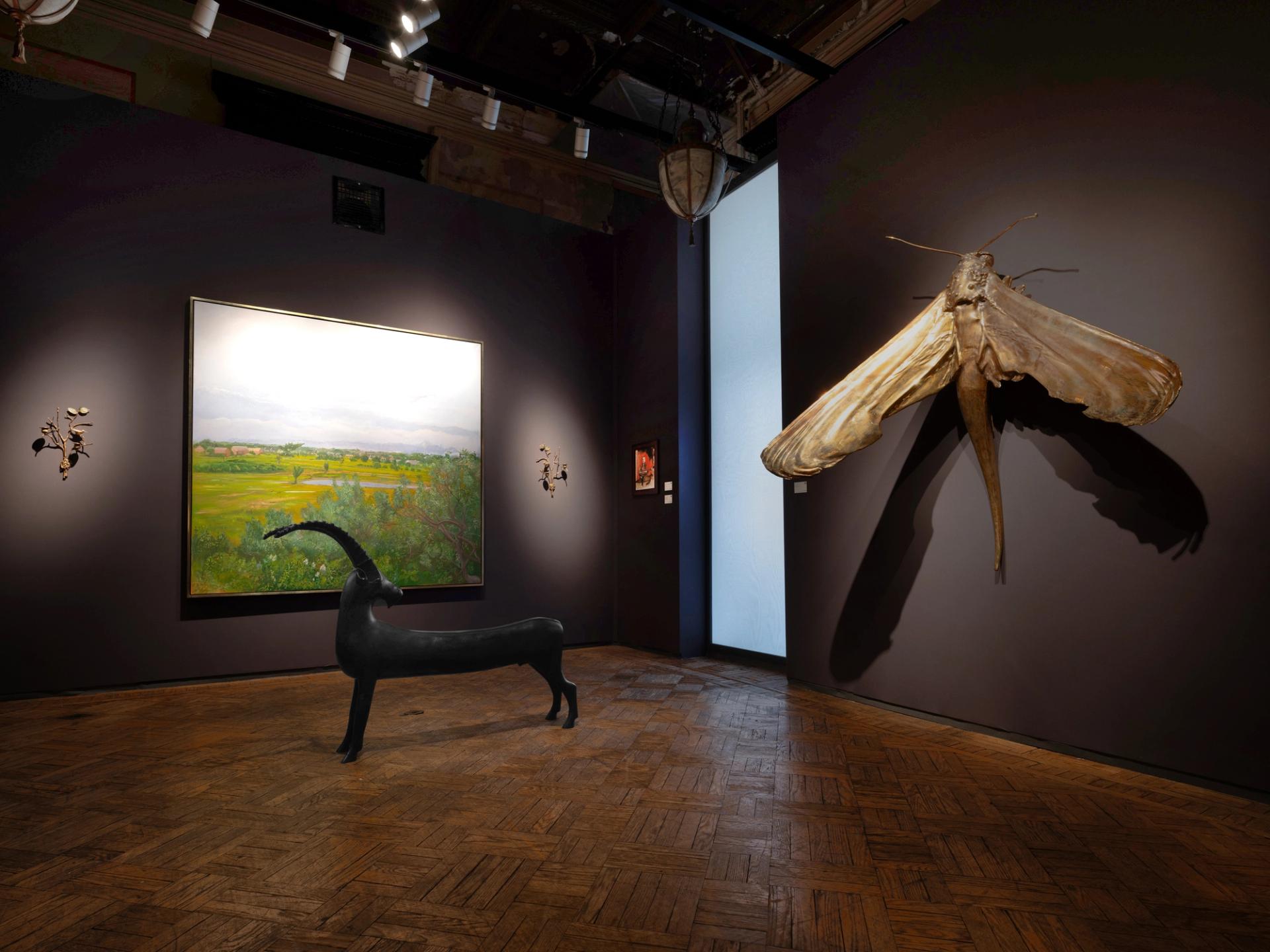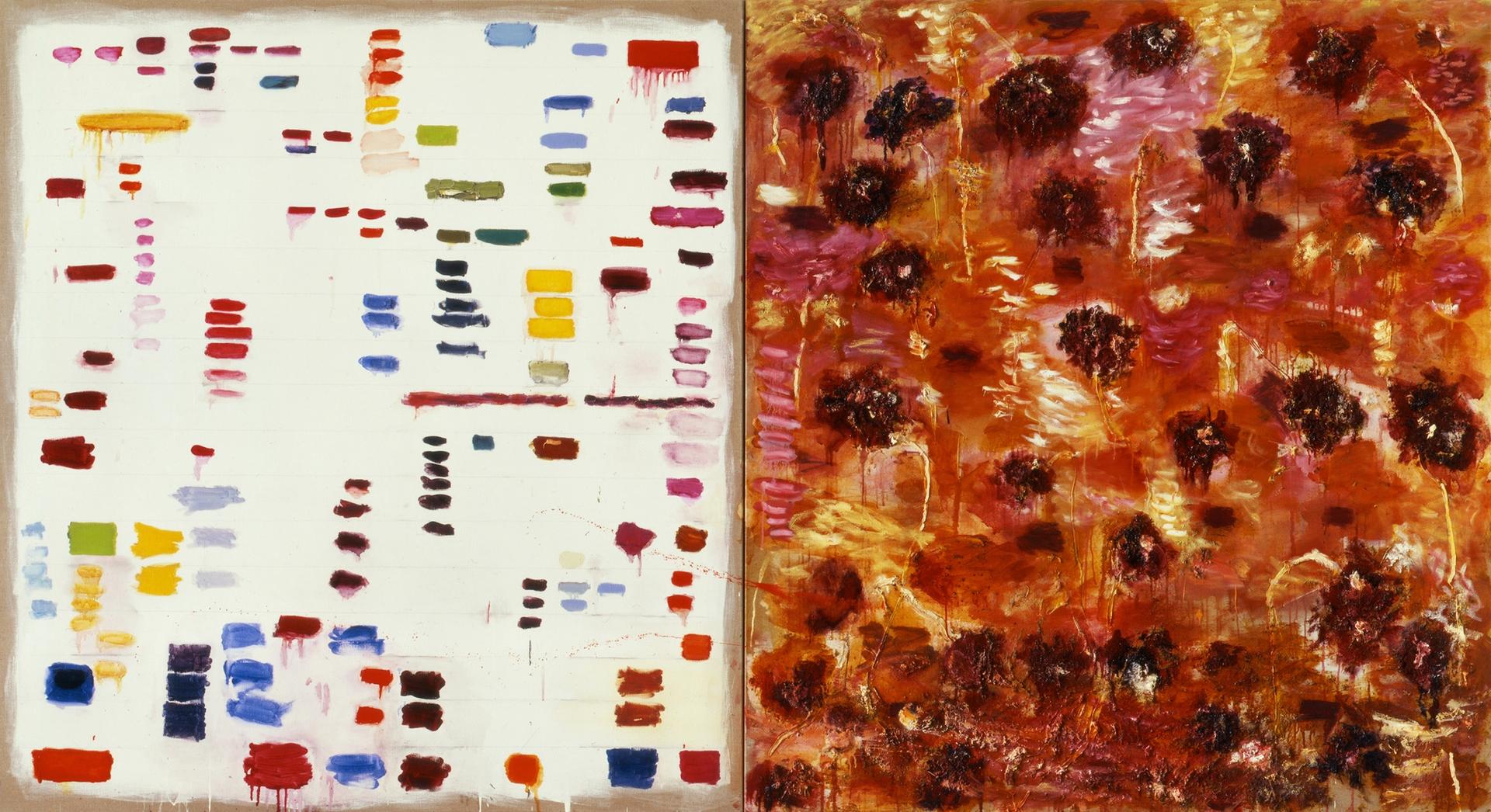Entering the second consecutive multi-fair week in the New York art trade’s May diary, it was reasonable to wonder whether the abundance (if not overabundance) of supply might undo any sense that the market has perhaps at least begun to stabilise. But the Thursday preview of The European Fine Art Foundation’s (Tefaf) expo in the Empire City provided a jolt of cautious optimism that the market’s trend lines are indeed pointing up, even if at a shallow angle.
The 2024 edition of Tefaf New York (until 14 May) brings around 90 exhibitors to the Park Avenue Armory, with the spotlight more directly on Modern and contemporary works of art and design than its larger, more classically minded predecessor in Maastricht. (That said, this March was the first time that Tefaf Maastricht featured more Modern and contemporary exhibitors than dealers with a pre-20th-century mandate.) Yet the adjustment in temporal focus has done nothing to downgrade the fair’s well earned reputation as what LeeAna Wolfman, a director at Templon gallery of Paris, Brussels and New York, calls “the créme de la créme” of the sector.
This year marks Templon’s second showing at Tefaf New York. Wolfman says the gallery saw participating in the fair as a way to “galvanise” its presence in the city after Templon expanded to Chelsea in the autumn of 2022. Its stand includes works by a range of artists from the gallery’s programme, including thematically rich figurative paintings by Philip Pearlstein (priced between $175,000 and $200,000) and Michael Ray Charles (around $175,000 to $225,000), as well as a discrete, domestically scaled sculpture by Chiharu Shiota ($100,000) using the artist’s beloved webs of thread.
One would never be able to intimate any softness in the market based on the crowds flooding the Armory’s aisles throughout Thursday. “There’s a good feeling in the air. I don’t sense that fatigue,” Wolfman said during the opening hours. “We’ll see if that translates into transactions.”
Asked whether the deals tend to close a bit slower at Tefaf New York than at some other fairs, she says that the speed and frequency of sales typically depends far more on the mentality of each individual collector than on any fair or the larger mood. “On some level it makes sense that higher-quality, higher-priced work would take more time to place. But for some people, a $10,000 work of art can take a lot of consideration.”
A view of Tefaf New York’s 2024 edition from the balcony level. Photo: Jitske Nap, courtesy Tefaf.
Quality control
Nearly every dealer The Art Newspaper surveyed remarked that there was plenty of work worth serious consideration this year. “The quality is very high. It doesn’t feel like any other art fair,” says Alex Logsdail, the chief executive of Lisson Gallery, when asked why Tefaf New York is the gallery’s expo of choice in the city’s May maelstrom. “People really see great art here. You can focus.”
Collectors’ ability to concentrate paid dividends for Lisson early. The gallery had placed at least eight works by Thursday evening. The priciest was Anish Kapoor’s Brandy Wine (2024), a deep red iteration of his signature stainless steel and lacquer mirror works, which sold for £625,000. Olga de Amaral’s Nébula 7 (2015) was the next-highest seller at the stand, going for $220,000.
“The market overall has improved significantly since last year, at least from our perspective. But equally, it’s no longer frothy. The days of everyone selling everything they brought are gone. People are being discerning about their decisions,” Logsdail says, adding that clients are “back to basics” with the questions they’re asking before deciding to buy: “Is it historically significant? Is it a great example of the artist’s work? Is it the correct price?”
The early returns proved that discernment can sometimes go hand in hand with quick decisions and hefty deals. Almine Rech gallery made a big splash on opening day, announcing that it had placed a small Picasso painting for between $1.8m and $2m, as well as a work on paper by the artist for around $500,000. The gallery also closed deals for lower-priced paintings by Kenny Scharf (for between $180,000 and $200,000) and Brian Calvin (around $50,000), along with a bronze sculpture by Claire Tabouret (around $100,000).
Tina Kim Gallery, a longtime exhibitor at Tefaf’s events in Maastricht and New York, also received a warm welcome at the seven-figure level with its stand largely oriented around Korean masterworks from the 1970s. The offerings were led by an early greyscale Park Seo-bo piece with an asking price of $1.5m; it was placed before night fell on preview day. Junni Chen, a director at the gallery, says that Tefaf New York is “a fair that’s very strong for us. We meet a lot of collectors, and we’re always very successful”, particularly with historical works.
From past to past, from four to seven figures
Because of the unique identity established by Tefaf Maastricht, the organisation’s New York fair already has an appetite for prime historical works “in its DNA”, says Nicholas Olney, the president of Kasmin gallery. This unusual latitude empowers the gallery to take “an ambidextrous approach” to its offerings, equally championing contemporary and canonical works.

Kasmin gallery’s stand at Tefaf New York in 2024.
Courtesy Kasmin.
Fittingly, Kasmin has devoted its stand in one of the Armory’s historical period rooms to a curated selection of works spanning almost a century, from Picasso’s 1923 drawing Nu Debout (baigneuse) to the contemporary sculptor Alma Allen’s showstopping, wall-bound bronze dragonfly from 2022. The presentation foregrounds unexpected formal and thematic throughlines between artists across generations, many of them anchored by explorations of the natural world. Prices range from $36,000 to $2m overall. A collector netted Allen’s dragonfly for $65,000 on preview day, one week ahead of the opening of the artist’s latest solo show at Kasmin on 16 May.
Although the gallery occupies multiple spaces only around 50 blocks away from Tefaf’s perennial home in New York, Olney says that the fair draws “a really excellent clientele that we don’t see in Chelsea all the time”. He adds that the mix includes “a little bit of everyone”, including a tranche of out-of-town clients, at least some of whom plan to stay through next week’s auction cycle.
The New York-based art adviser Liz Parks says there were “some moments of sticker shock on prices for artists perhaps canon-adjacent but not yet in the barrel” inside the Armory, while also noting that the same was true downtown at Independent, which also opened yesterday. But she added there were also “some pleasant pricing surprises” at this year’s Tefaf New York, singling out Petzel gallery’s stand of works by Roger-Edgar Gillet.
Although high quality and high prices typically coincide, in several transactions announced on Thursday, buyers and sellers came together at conspicuously modest price points relative to Tefaf’s high-touch reputation. Along with the higher-priced pieces by Kapoor and De Amaral mentioned above, Lisson also placed five small works by the late postwar Japanese sculptor Masaomi Yasunaga for between $4,000 and $12,000 each. Thaddaeus Ropac, which dedicated its stand to works by the American abstractionist Joan Snyder, sold Primary Fields (2001) to an institution in Asia for $350,000 and WallGarden (2015) elsewhere for $160,000, while six of Snyder’s works on paper found buyers for $15,000 to $40,000 each.

Joan Snyder, Primary Fields (2001). © Joan Snyder. Courtesy Thaddaeus Ropac gallery, London · Paris · Salzburg ·Seoul
Sean Kelly Gallery’s sales spanned a similarly wide range. A spokesperson for the dealership relayed sales of seven pieces on opening day, with two reaching into the low six figures: a large-scale Alec Soth photograph from 2002, for $135,000, and Kehinde Wiley’s Aluel Mareng Study (2023), painted in oil on paper, for $100,000. But another four were priced lower than $50,000, including a new cyanotype collage by Wu Chi-Tsung for $42,500, a pair of Antony Gormley drawings (£22,500 and £35,000) and a 2023 Hugo McCloud flower work made with paint and single-use plastic for $30,000.
It is almost undeniable that dealmaking will always be paramount to a fair’s perceived success. Yet a high-quality presentation can also buoy dealers, collectors and advisers in ways that invigorate the art market’s animal spirits well after this event closes. On that level, Tefaf New York seems to have succeeded.
“Tefaf was like a meander down a brackish coastal river, its banks festooned with flowers, its waters fertile with both oysters and exceptional art and artefacts, one’s personal paddle boat stopping constantly to marvel at the view. It feels as if joy has been restored to collecting: despite the large crowd, there was time to stop, peruse, contemplate, enquire,” Parks said of the fair in an email to The Art Newspaper Friday morning. “My phone’s camera roll reads like a survey class in Art History’s slide carriage.”
More importantly for Tefaf, its exhibitors and the trade overall, collectors are paying US university tuition rates to take a part of the experience home with them, too.
Tefaf New York, until 14 May, Park Avenue Armory, New York





















